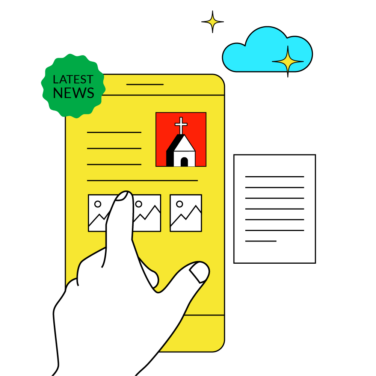In my experiences working in churches, I’ve discovered several church communication best practices that I’ve used to avoid all manner of miscommunications and mishaps (some of which were learned the hard way!)
Here’s a scenario:
The printed flyers for your church’s 10th year anniversary have just been delivered. As you review, you get a sinking feeling in your stomach. Why? You somehow forgot to include the date of the event on the flyer. That’s not all: you also notice a typographical error. What a costly mistake! The flyers have to be redesigned and reprinted, all 5,000 of them.
Sadly, it is no fault of the printing company. They sent you the draft and you gave the final approval before it went into print. But this could have been avoided with a proper communication process and strategy in place.
The best practices shared in this article will help to ensure that the intended audience gets your message clearly with minimal to no interference. This will in turn improve turnout at your church’s planned events, increase clarity on your mission and values, and help ensure your congregation and staff members are clear on all the happenings at your church.
I share from my 20+ years experience as a church leader and administrator. I highlight the best practices that I’ve learned, and I also cover several of the most common problems in church communication.
In this article, I’ll cover:
6 Best Practices For Church Communication
Here are my best practices for ensuring communication within your church helps you spread your message and mission, instead of hindering it.
1. Over Communicating Beats Under Communicating
Sharing an important announcement once does not usually get the job done. There are so many things vying for our attention today that the congregation or intended audience may not remember the announcement once service ends, or once they leave church premises. This is why reminders are imperative. Build reminders into your weekly services, have the information on your church website, and include it in your weekly bulletins (see some church bulletin examples here).
2. Use A Variety Of Church Communication Software
Church communication software is a broad term that can include any type of software or tool that helps you communicate with your congregation or conduct internal communication with your staff.
Here are a few ideas for types of tools and software you might use. These are great ways to reiterate church announcements.
Mass mailing services such as Mailchimp, Flodesk, or Constant Contact are just a few of the many online email marketing automation platforms that allow you to send one message to hundreds and even thousands of people on your mailing list. These platforms generally require a small monthly fee, although in some cases they might be free, depending on the size of your congregation.
Within these platforms, you are also able to categorize email lists. For example, one category of emails can be for heads of departments, another might be for your general congregation or just new church members, and so forth. This is a very convenient feature that allows you to send certain messages to only the people that need to receive them.
Read more about church email marketing here.
Mass Text Messaging
This type of software is great for sending text message reminders about events to your congregation. Flocknote, EZ Texting, and ChurchCast are just a few of the mass texting platforms that allow you to text your entire congregation at once.
Remember to keep the messages short and straight to the point. No one likes to read lengthy text messages.
Social Media
By this point, your church should be using social media, be it Facebook, Instagram, or Twitter. Generally, these pages are public-facing (meaning anyone can see them, unless you adjust your settings to disallow this), so keep in mind that both the intended audience and anyone else who stumbles across your profile can read the information you post here. Not all messages should be posted here, unless the general public is your intended audience.
For example, if your church is hosting a blood drive, or a business fair open to the general public, you will want to post these types of messages on your social media pages. However, a reminder about the upcoming ushers’ meeting should not be posted on a public platform.
Group Chat Applications
WhatsApp (which usually works better for smaller churches) is a favorite and reliable application. You can create a dedicated WhatsApp Group Chat for important church messages and announcements, and use it to reiterate messages or send reminders about upcoming events.
You may need to set boundaries and let users know that the page is strictly for church information. You do not want messages or reminders to get lost in a myriad of other unrelated posts and memes.
Send Reminders Via Heads Of Department
Each head of department or unit at a church will have their trusted and reliable way of communicating with members of their department. You may want to ask them to remind their department members about an upcoming church event that requires their attendance.
For example, you can ask the choir director to remind her department about an upcoming worker’s training seminar. Highlight the specific information that you want shared with departmental members.
3. Emphasize Messages During Church Services
Right before the actual sermon or after it are great opportunities to relay general announcements, upcoming events, and any other tidbits that your congregation at-large should know.
However, avoid overloading announcements: Plan ahead so your church’s weekly announcements are properly spaced. Having too many announcements at one service will lead to people forgetting or missing information.
Ensure that the announcer at the service receives the announcements in good time: This will give enough time for them to review and prepare. Sending the announcements the night before the 8 am service is bad communication practice.
4. Promote Events In A Timely Manner
This is key. If you start to talk about an upcoming event too early, it may dilute the significance of the event as the day approaches because your intended audience has heard it one time too often.
There are a variety of ways to go about mass promotion of major church events: Flyers, posters, banners, or digital adverts. Make sure to use a consistent color theme for all publications. This helps with easy recognition and branding. Decide on a color scheme and use those colors consistently in the creation of posters, flyers and banners—be it digital or hard copies.
5. Double Check Your Work
The scenario I posited in the intro is actually a true story. When I was the administrator of a large international church organization, I learned this lesson the hard way. At the end of what had been an extremely busy work week, I accidentally approved the printing of posters and flyers for a major event. Regretfully, there was a major typo—which I missed.
That painful and costly experience led me to develop an almost foolproof system that I use before approving any information intended for wide distribution.
I created a checklist that includes a list of basic information that goes into every form of mass advertisement used at that church. The checklist included:
- Date of the event
- Time of the event
- The venue
- Website address of the church
- Telephone number of the church
- Name of event
By having this checklist handy, I was able to cross-check before giving the go-ahead to print or distribute digitally.
The second step of my system involved enlisting the assistance of at least two other trusted individuals (members of the event planning team) to check to ensure I did not omit important information.
The truth is we are humans and are prone to human error. Having a good system in place will greatly reduce or eliminate costly human errors altogether.
6. Pay Close Attention To The Design Of Any Promotional Material
Let’s say you are organizing a free back-to-school give-away. You want to make sure the purpose of the event is clear at first glance on any flyers or ads. This might mean having the title bolded, along with photos of backpacks and school supplies. A photo of the pastor should not be the most prominent image on the flyer.
Busy designs unrelated to the message take away from the importance of intended messages. Unnecessary floral designs and graphics just make it hard to read the message that you are trying to convey. Your intended audience should not have to fight through unnecessary designs to get to the actual message.
Also, make sure to clearly explain any specific instructions that event attendees will need. For example, say your church is having a toy drive. You’ll want to make sure the following is clear:
- The types of toys needed or required.
- The toy collection deadline.
- Where donors should put the toys. For example, toys should be placed in the collection bins at the main entrance, in the lobby.
- Whether cash donations will be accepted in lieu of toys, for those that are unable to purchase toys due to time constraints. How should they make the donation? If giving online, should they type “toy drive” when making their donation? (PS: learn how to write a proper church donation thank you letter here.)
- Whether “toy drive” should be written on the giving envelope.
All of these instructions and more have to be clarified and spelled out to improve the chances of success of your drive.
Common Church Communication Problems
Keep a watchful eye on your communications to ensure you avoid the following:
Ambiguity In The Message
Clarity and specificity are important when crafting your messages—this helps to ensure your messages are clear, well understood, and received by the target audience.
Creating a church communications plan or communication strategy can help you ensure your messaging is clear and consistent, to drive effective church communication.
Here’s an example:
- An ambiguous message or announcement might simply state: the senior pastor is meeting with church leadership next Sunday after service.
- A clear and specific version of the same message might read: the senior pastor is meeting with elders and associate pastors next Sunday after service to discuss plans for the annual summer picnic event.
Too Many Events
If you schedule too many back-to-back events, You might wear out your congregation, and you shouldn’t be surprised at a poor turnout at your church events. Your congregation is just tired and needs to recuperate from last week’s event that required all hands on deck and 2 months of planning.
Timing
Does the day and time of the event work for the majority of the intended audience? Not many people will show up if you set a meeting for 6 pm and the majority of those that are expected at the meeting do not finish work until 5.30 pm or 6 pm.
Lack Of Post-Event Meeting
Holding a post-event meeting can help you and your staff analyze how the event went, what could be done better, and what went well, so that you can improve future events.
Let’s say you are planning a repeat of an event that was held before, but the previous event did not meet expectations. If you don’t hold a post-event meeting, solicit feedback, or create a survey to help with improvements at the next event, you can expect a similar disappointing result at the second event.
Go, Implement, & Excel
Implementing all of the aforementioned will not only help to improve the communication practices at your church, it will also lead to better turnout at your events. I hope these strategies will also enable you to identify other areas for improvement in your church communication practices.
If you’re having trouble getting your church communications in order (or even the general administration and management of your church), consider using church management software or a broader church software to start running things smoothly.
And, should you find yourself feeling disconnected or uninspired - you may need refreshement. Consider registering for a church media conference. We've got this year's recommendations ready for you.
Related Read:


